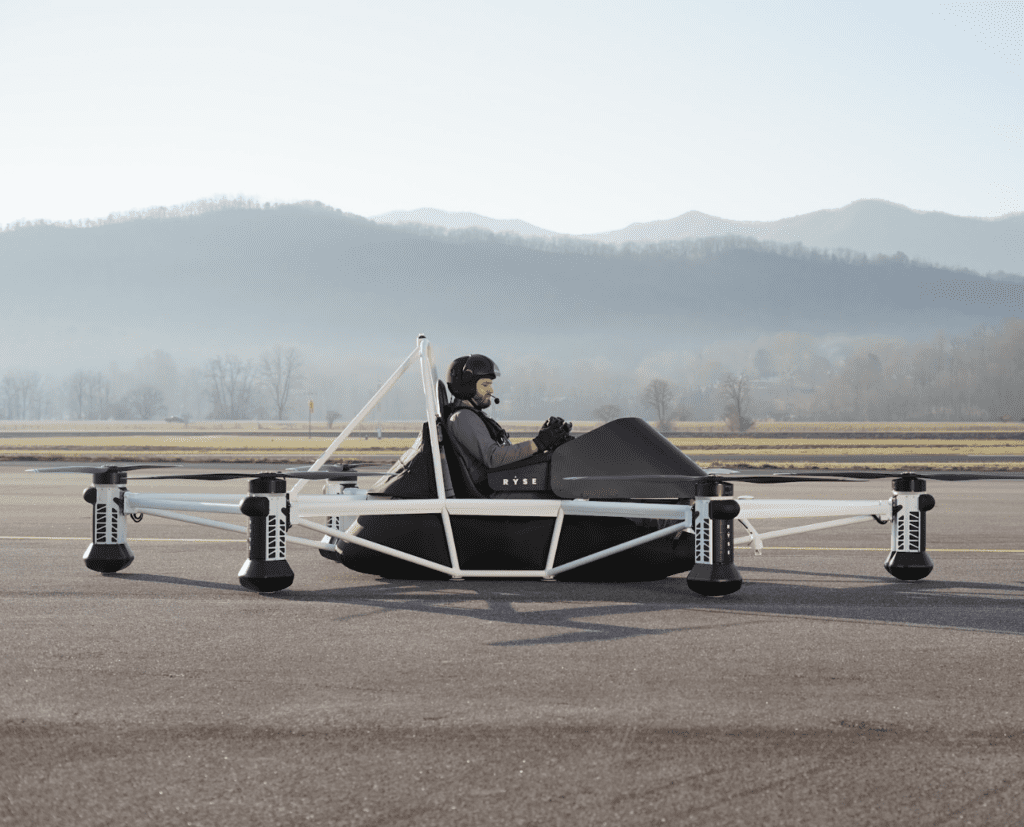
Ultralight eVTOL developer RYSE Aero has started conducting manned test flights with its RECON aircraft. (Photo: RYSE)
RYSE Aero Tech, electric vertical takeoff and landing (eVTOL) developer, announced this week that it has begun conducting manned test flights of its ultralight eVTOL, the RYSE RECON. The aircraft does not require a pilot’s license to operate because it falls under the specifications of 14 CFR, Part 103. RYSE expects to start delivering its eVTOL to customers in the second quarter of 2023.
The first manned flight of the RECON took place on June 27 in Ohio; a video of the flight can be viewed here. Some of the vehicle’s key features include a top speed of 63 mph (based on Part 103 specifications), the ability to operate on land and water, and a 25-mile maximum range. The RECON has six independent propulsion systems with rechargeable batteries.
RYSE designed its aircraft with a rugged structure that makes it ideal for agricultural applications and operating in difficult-to-reach areas. However, the RECON was not designed specifically for performing any one activity, explained RYSE CEO Mick Kowitz. “What we started to do was design an aircraft that met the requirements of Part 103, which is sport and recreation,” he told Avionics International. It just so happened that a lot of the functions for sport and recreational activities can also apply to agricultural, logistics, and first response missions.
“We’re looking to the farming community to help us figure out the actual applications specifically,” Kowitz said.
“It was designed to meet two standards: to be under 254 pounds—the ultra light class—and to be something easy to use that farmers, first responders, and anybody else could implement in a meaningful way. The idea was to keep it as light and as simple as possible so that they can figure out what they want to do with it.”

New operators will go through a 45-minute tutorial before flying the RECON eVTOL. (Photo: RYSE)
RYSE’s team built the RECON aircraft and the controls in parallel. The flight controls include two joysticks that work both independently and together, and a touchscreen display with a map to indicate the aircraft’s location. The touchscreen also adds redundancy to the flight control system if the joysticks stop working, and vice versa.
Before flying the aircraft for the first time, a new operator will go through a 45-minute tutorial that includes instructions for taking off, performing a water landing, doing a pre-flight walkaround, and dealing with different kinds of emergency scenarios.
According to Kowitz, “It’s very simple to operate. It’s not overly touchy. We’ve designed it so that it has a little bit of sluggishness to it.” He added that all of the controls are proprietary. “Our control model is based on a combination of things we’ve learned in the past in aviation, and even in the automotive industry, like when you move to an operator versus a pilot operating a vehicle.”
The RYSE Aero team started conducting remotely operated flights at their facility in March. By June, Kowitz said, they were confident that the vehicle stability and all of the redundancies were in place to ensure safety for manned flight. “We didn’t anticipate any problems, but we were fully prepared for them,” he remarked.
He estimates that they have likely flown 120 hours on the RECON aircraft so far as they explore its capabilities. The focus now is understanding the use cases for farmers and ranchers. For the next few months, Kowitz explained, they will be observing how others use the vehicle. “We’ll make sure we have all the constraints and all of the training in place to get them going,” he said.

“We are following a vast majority of the same standards [as other eVTOL developers]; we are, but we’re not required to. So we have a little more leeway from that perspective, which is one of the reasons why we are interested in ultralight. More importantly, we’re interested in bringing flight to everyone. People being able to use this purposefully, I think, is really valuable.” – RYSE’s CEO, Mick Kowitz (Photo: RYSE)
“We think a Q2 deadline is achievable” for launching deliveries to customers next year, said Kowitz. He mentioned that the major eVTOL developers are working on airworthiness certification within Part 135; since RYSE’s ultralight aircraft operates under Part 103, the main challenge is the manufacturing component.
An advantage of the RYSE team, when it comes to manufacturing the aircraft, is that they possess a lot of previous experience with the electric automotive industry. According to Kowitz, “We know what the manufacturing world is really like and what it requires—batch testing, spot component testing from a multitude of manufacturers—and all those processes are really the complicated ones.”